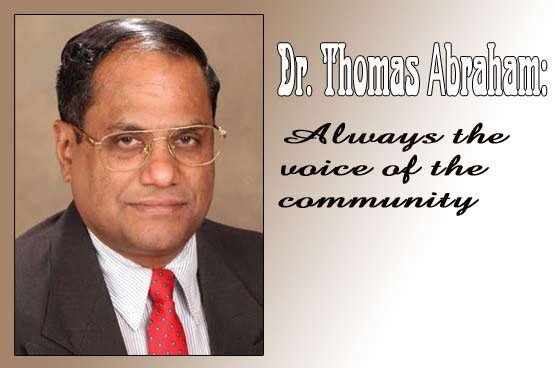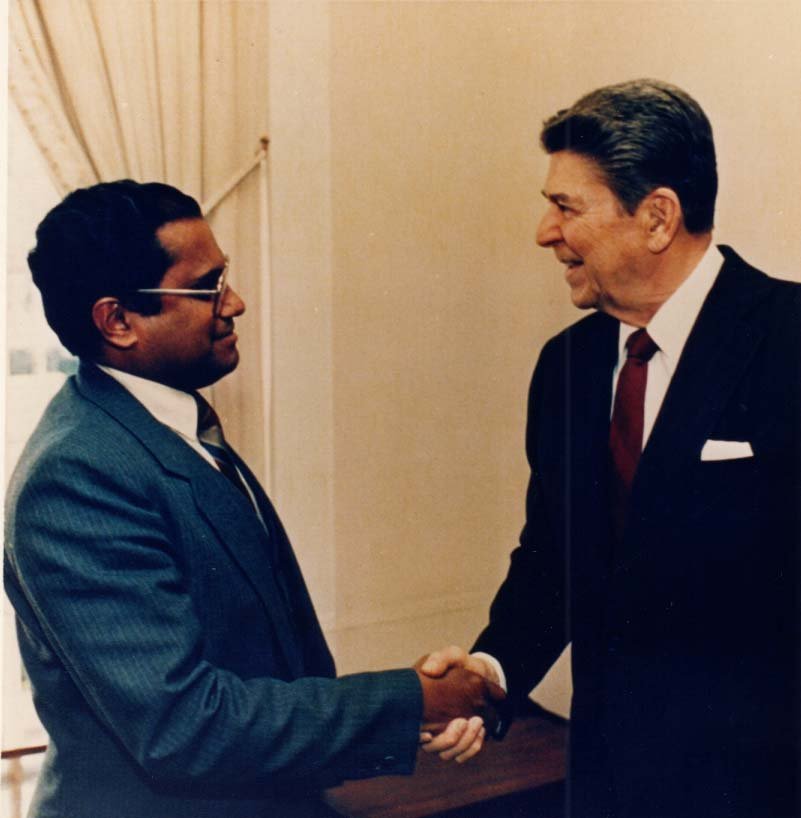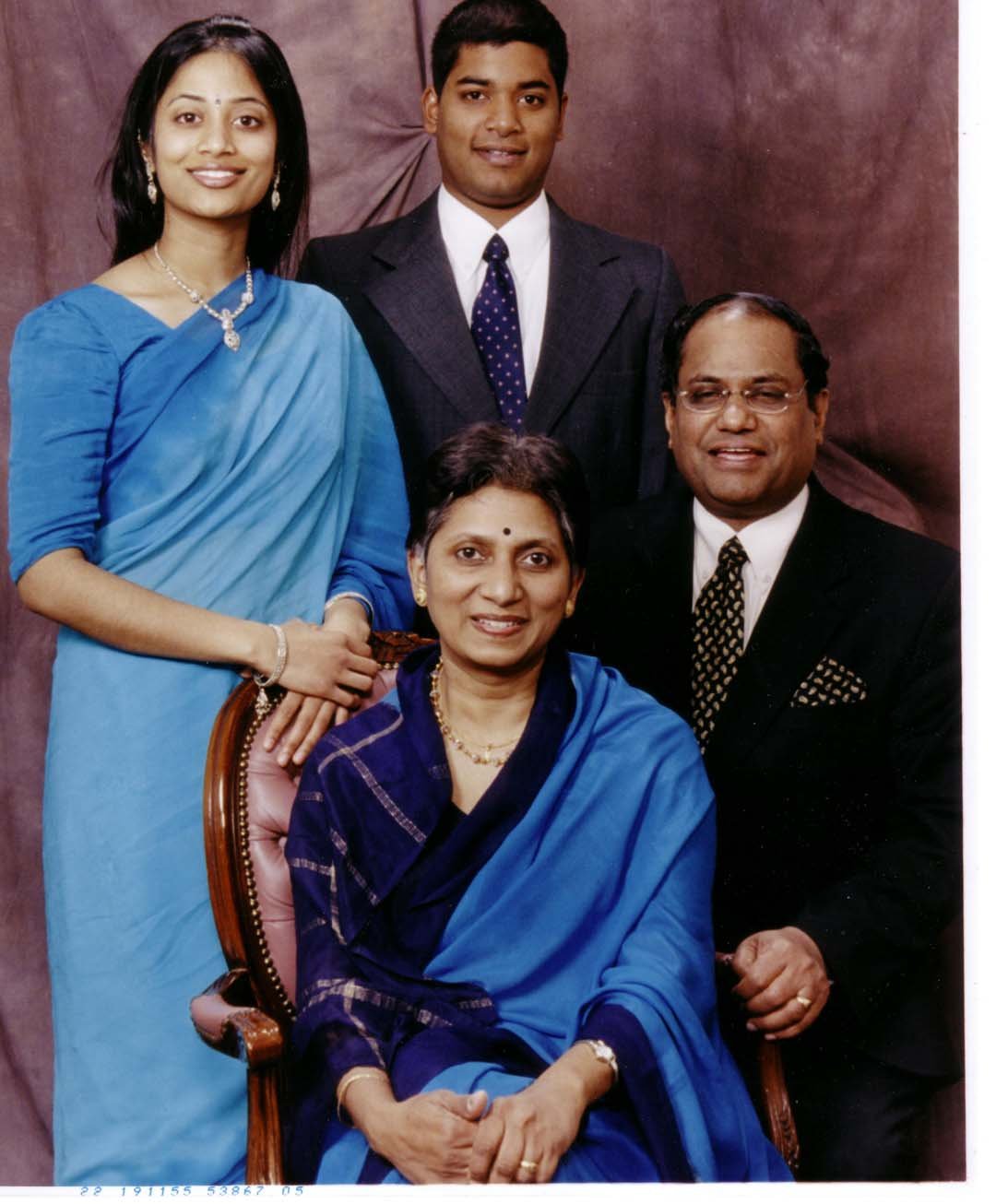America
Dr. Thomas Abraham: A life dedicated for the community-1

Unlike the early immigrants, who landed with $8 in their
pockets, Dr Thomas Abraham arrived at JFK with $75 in his pocket.
“Those days, Government of India used to give $8 for anyone who travelled abroad. I got a special permission to get some additional dollars. I did not want to spend the money for taxi, therefore, took a bus to Grand Central Station and then by subway to Times Square and then to Columbia carrying a suitcase and went to the dormitory,†he remembers that day.
The Henry Krumb School of Mines at Columbia University
had offered him an assistantship in 1973. Dr. P. Somasundaran, professor at the
school of mines, still remembers the academic record of Abraham.
Those days, many areas of New York were run down with a lot of crime.
This was a time when the Hippy movement was still going strong. The Hare
Krishna devotees were all over the place. Times Square
was filled with shops showing pornographic films and live sex shows. Harlem was
the crime center of America,
Abraham remembers.
Early life
The journey begins from Kozhencherry, Kerala, where his family has been farmers. His father was a lawyer and moved to nearby Pathanamhitta to practice law.
As one among eight siblings, the family could not afford to send him to better schools and he started education at the only elementary school in the town run by the local mosque, the Muslim Lower Primary School. He finished the high school from the Mar Thoma High School.
After the pre-degree or the current plus two, at the Catholicate College
in Pathanamthitta he joined the Malaviya
Regional Engineering
College (now known as
Malaviya National Institute of Technology) in Jaipur and earned a bachelors in metallurgy.
“The IITs were coming up. But I did not know that to get into it one needs to write an entrance examination. The REC was the other option.â€
“When I reached Jaipur in 1966, I could not speak English or
Hindi as the medium of instruction in Kerala was Malayalam. But five years in
Jaipur changed all that. There were students from all over India. It
provided me an opportunity to know and understand the sub-regional cultures of
people from different parts of India.â€
He was not yet in public life except for being active in the
student chapter of the Indian Institute of Metals. “Life in Jaipur was the
transformation period where I could expand my horizon from being a student from
Malayalam medium schools and changing over to English and Hindi.â€
Those days in the late 1960s and early 70s, engineers faced
difficulties in getting jobs. It led to a demonstration by engineering colleges
in front of the Indian Parliament in 1968. He was selected among two dozen
students to travel to New Delhi
to participate in the demonstration. A large number of the demonstrators were
arrested and were put in Tihar Jail. Soon Government of India decided to
provide Rs. 250 as a stipend for unemployed engineers.
After his graduation, luckily he was offered a job as a lecturer at his alma mater, where he worked for four months before joining as a metallurgist at Alcobex Metals in Jodhpur. “This new job of managing a non-ferrous metal foundry and processing unit and supervising over 100 workers provided me the management skills. Since most of the workers did not write or speak English, I was forced to read workers’ handwritten leave applications and other documents in Hindi which made me to communicate well in Hindi.
“Life was not easy since there weren’t hotels near the
factory. One had to go to home for food in the extreme summer heat on a bike
and return for work. In a way, it was an excellent training.â€
At Columbia
When he arrived at Columbia, it had a very active Indian student association, known as India Club of Columbia University. The club has been screening Hindi film every weekend. For most Indians then, their only connection with India was the Bollywood films and some radio programs. A large number people flocked to watch Hindi films. The club earned money from screening the films.
He took over as the president of the India Club in 1975. The club was not doing well.
“I introduced changes and added other community programs
including the biggest Diwali show till that time, in 1975.â€
It was a time many organizations were coming up, several on
religious and regional basis. These organizations were celebrating India’s
Independence Day and Republic Day under the banner of the Joint Committee of
Indian Associations hosted by India Club. Abraham saw a need to organize and
bring the community for common causes.
But the Joint Committee under him was left with no finance. “We, four students from Columbia University, contributed $100 each to start a new account for the organization. Our first objective was to set up the organization back again and to pay for the expenses for the upcoming India Independence Day Celebration in 1976,†Dr Abraham remembers.
“We were also
confronted by people who were opposed to the Emergency in India who tried
to disrupt our celebration. One major decision we took at that time was that
whatever be the political situation in India, we as a community will not
take any sides.
“At the same time, another Indian group did not want us to
do anything with Indian celebrations since they advocated at that time that
they were Americans only!â€
By 1977, credibility was restored as an umbrella organization promoting and supporting all Indian cultural and language based groups. “The next step was to bring them actively involved in the community issues. The decision was made at the Joint Committee meeting in December 1977 held at Columbia University that we will incorporate a new organization, i.e. the Federation of Indian Associations (FIA) with a new constitution and it was incorporated in March1978 in New York State.â€
It started organizing the Independence Day program since 1977 in an open area such as the College Walk of Columbia University. Thousands came for the Indian Day Festival.
During this time he also helped initiating FIA umbrella organizations in all major cities of the United States.
In 1980, FIA organized the First National Convention of
Asian Indians in North America. The National
Federation of Indian-American Associations (NFIA) was born at this convention,
which elected Abraham as president. Today, it is the largest Indian
organization in America,
and has over 200 Indian organizations as its members. He served as the NFIA president
from 1980-88; and chairman of its board of trustees in 1988 and ’92.
With the success of the convention in 1980 and several other activities, FIA took the next step in organizing the India Day Parade in 1981. Sureshwar Singh, who worked as secretary earlier was the president of FIA then.
In 1976, the community joined hands with other ethnic groups
to celebrate 200th anniversary of American Independence. “Since then we joined
with other Asian groups for common causes including the campaign to declare May
1st week as the Asian American week. This was the beginning of our Indian
community exerting pressure in legislative issues.
Organizations
Dr Abraham coined the word PIO (people of Indian origin) in 1989, when he put together the first convention of People of Indian Origin in New York. Currently he is the chairman emeritus of Global Organization of People of Indian Origin and Executive Trustee of GOPIO International Foundation.
Many of the national, secular organizations were initiated by him and he credits it as his greatest achievement in life. They include:
Federation of Indian Association (FIA) of New York, New Jersey and Connecticut – 1977
National Federation of Indian-American Associations (NFIA) – 1980
Global Organization of People of Indian Origin (GOPIO) – 1989
Indian American Kerala Cultural and Civic Center – 1993
Jagdish Bhagwati Chair for Indian Political Economy at Columbia University ($4 million endowment) – 1992-2000
National Indian American Association for Senior Citizens (NIAASC) – 1998
South Asian Council for Social Services (SACSS) – 2000
The Indus Nanotechnology
Association (TINA) – 2011
Through these organizations, Abraham helped to build a solid
base for Indian American community as well as the Indian Diaspora spread out in
various countries. A follower of Gandhian principles of peace and non-violence,
he had taken several initiatives for organizing programs of community harmony.
As president of FIA and NFIA, Abraham has organized large community meetings for former Prime Ministers Morarji Desai, Indira Gandhi and Atal Bihari Vajpayee.
He took the initiative in organizing the first Indian American Hotel and Motel Conference at the NFIA’s National Biennial Convention in 1986, which has grown in to the Asian Indian Hotel and Motel Association. The many alumni organizations too can trace their origin to the first NFIA conference held in 1980. The convention provided platforms for alumni of all major institutions in India. These groups continued their alumni get together at NFIA conventions for a few more times, before they become themselves very strong and made their own conventions.
Abraham’s vision of mobilizing the community at different
platforms were visible.
He also served as the national coordinator for the American
Committee for the Rehabilitation of Cyclone Victims in India in 1978, chairman
of the Committee to Honor the Prime Minister of India in 1978 and 1983, vice-president
of the Indo-American Council which was responsible for promoting the Festival
of India in 1985-’87, and national coordinator, Asian Indians for Liberty which
collected substantial funds for the restoration of the Statue of Liberty and
Ellis Island.
Dr Abraham’s list of achievements runs endlessly. In early
1980, he was invited by the Select Commission on Immigration to testify on
behalf of the Indian community on the various rules governing the new
immigration law. This along with efforts by other organizations helped to
preserve the family reunification clause of the new immigration laws ratified
by the US Congress.
In 1988, NFIA under the leadership Dr Abraham testified in
the US Senate to stop the supply of sophisticated military equipment including
AWACS to Pakistan.
In 1992, the Indian community in New
York and the Indian Embassy jointly took decided to establish
chair for Indian studies at Columbia
University. Dr Abraham
was the co-chair and the India
chair was inaugurated as Jagdish Bhagwati Chair for Indian Political Economy in
1997.
Family
He has two brothers and three sisters back in India and two other sisters in UK.
Seeing that many Muslim would not send their girls to school, his father started a girls high school in Pathanamthitta in the 1950s. It is a government aided school and now it admits boys also as it is difficult to get students nowadays! So many private schools have come up and they compete for students and usually the government aided ones are the losers.
His father was also noted for other charitable and
philanthropic work in the home town.
Abraham is married Dr Susy Abraham, an internist and geriatrician at Sarah Neuman, the Westchester Campus of Jewish Home and Life Care.
His daughter Dr Nitya Elizabeth Abraham is a urologist and son
Jay Thomas Abraham is a design engineer.
Professional work
As an advanced materials scientist specializing in advanced ceramics, Dr Abraham came across nanoceramic powers as early as 1990s. He organized the first ever business nanotechnology conference connecting lab technology to business in 1998 in New York. People from all over the world including Russia and China came to attend it.
Since then he has been organizing nanotechnology conferences every year.
As the many other organizations, he launched The Indus Nanotechnology Association (TINA) last year to help in faster commercialization of nano-enabled technologies and related fields such as Nano-Bio Convergence, Nano-enabled Energy Generation and Storage, Nanoelectronics, Nanomedicine and other areas.
Dr Abraham is an expert in advanced materials and nanotechnology and president of Innovative Research and Products (iRAP), Inc., a Stamford, Connecticut based technology and market research firm.
Before, starting iRAP, he served as vice president for research at the Business Communications Co, a market and industry analysis company in Norwalk, Connecticut.
He also served as editor of a monthly publication, "High-Tech Ceramics News," for over seventeen years.
He had worked earlier at the University of Denver and Brookhaven National Laboratory.
He has written over 50 papers that are published in the
various professional journals and magazines.
Awards
Abraham has been honored with several community service awards including Federation of Indian Associations Award, Second International Malayalam Conference Award, Asian Who’s Who Award and Federation of Kerala Associations of North America Award for Outstanding Community Service. In 2012, he was honored with Life Time award for community Service by India Abroad.
He was presented with Bharatvanshi Gaurav Award by former Vice President of India Bhairon Singh Sekhawat and Pravasi Bharatiya Samman by President Abdul Kalam in 2008. He was also presented with the Outstanding Alumnus Award by the Malaviya National Institute of Technology (MNIT) at its annual convocation in November 2008.
(To be continued)





























